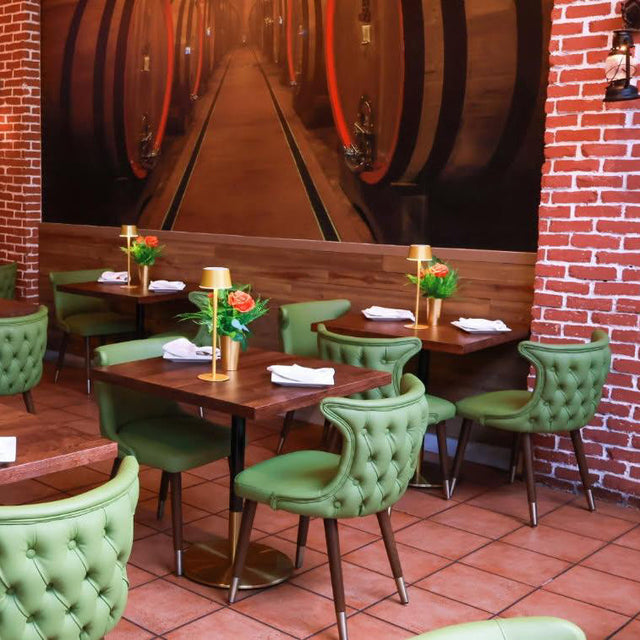Sustainable Restaurant Furniture: Eco-Friendly Choices for Conscious Businesses
The global awareness of environmental challenges - climate change, deforestation, overflowing landfills - has shifted consumer demands and industry norms. Today’s restaurant guests are no longer satisfied by good food and ambiance alone; they seek brands that reflect their values and act responsibly.
For restaurant owners and designers, this has birthed a critical opportunity: to differentiate and future-proof their business with genuinely sustainable practices, starting with something as fundamental as furniture. Sustainable restaurant furniture is not just a buzzword, nor is it restricted to earthy, rustic aesthetics.
Advances in materials science, eco-certifications, circular business models, and global supply chains have made it possible to create or source furniture that is beautiful, durable, and eco-friendly.
Why Sustainability Matters in Restaurant Design
Before making choices, it’s essential to define what “sustainable furniture” means in the hospitality sector. In simple terms, sustainable restaurant furniture is manufactured, distributed, used, and disposed of in ways that minimize negative impacts on the environment, maximize social benefit, and are economically sensible for businesses.
Core Principles Include:
-
Responsible Raw Material Sourcing: Using wood from certified forests, recycled plastics, repurposed metals, natural fibers, or innovative plant-based materials.
-
Low Environmental Impact Manufacturing: Minimal energy, water, and chemical use in production and finishing.
-
Longevity and Modularity: Furniture that is durable, repairable, and designed for long life or easy disassembly at end of use.
-
Non-Toxic Finishes and Components: Use of low-VOC (volatile organic compound) varnishes, adhesives, and fabrics, creating a healthier indoor environment.
-
End-of-Life Responsibility: Consideration for reuse, refurbishment, biodegradability, or recycling to support the circular economy.
For the restaurant industry, the challenge is to meet demanding hospitality standards for aesthetics and resilience - without sacrificing environmental ethics.
The Business Case for Sustainable Restaurant Furniture
Eco-friendly furniture is not just an ethical or branding decision - it can be a smart business strategy:
-
Meeting Customer Demand: Over 69% of travelers and diners report preferring eco-friendly establishments. Green interiors can be marketed as a differentiator and even support higher price points.
-
Conforming to Regulations: Local governments and global certifications increasingly require evidence of sustainable procurement. Early compliance builds long-term resilience and may net tax advantages.
-
Reducing Operating Costs: Many sustainable materials are longer-lasting and require less frequent replacement; energy-efficient manufacturing reduces the product’s overall footprint and may result in cost savings over time.
-
Positive PR and Partnerships: Sustainable restaurants are more likely to receive favorable media, influencer attention, and be included in eco-tourism directories.
-
Attracting Talent: The next generation of service workers prefers working for values-driven brands.
Key Sustainable Materials for Restaurant Furniture
The sustainable furniture revolution has brought forth a dazzling spectrum of innovative materials. Let’s review the most impactful options for conscious restauranteurs:
1. FSC-Certified and Reclaimed Wood
-
FSC (Forest Stewardship Council) Wood: Guarantees that timber was harvested from responsibly managed forests, protecting biodiversity and workers' rights.
-
Reclaimed or Salvaged Wood: Wood rescued from old barns, ships, or buildings repurposed for new tables, flooring, or chairs - each piece with unique character.
-
Benefits: Warm, classic esthetic, often more carbon-efficient than new timber, can last generations if properly maintained.
2. Recycled and Upcycled Metals
-
Recycled Steel/Aluminum: Both are endlessly recyclable without losing integrity; chairs and table bases made this way drastically cut embodied energy.
-
Powder Coatings: Modern powder coatings are now water-based and low-emission, replacing toxic paints for a sustainable, durable finish.
3. Recycled Plastic and Composite Materials
-
Post-Consumer Plastics: Seats and outdoor furniture made from recycled yogurt containers, water bottles, or ocean plastics.
-
HDPE (High-Density Polyethylene): Durable and weather-resistant, often used for modern outdoor furniture.
4. Rapidly Renewable Resources
-
Bamboo: Technically a grass, bamboo matures within 3-5 years, is strong, and can survive on rainwater - an excellent substitute for slow-growing hardwoods.
-
Cork: Harvested from the bark of cork oak without killing the tree. Lightweight and resilient, cork is used for chair seats, stools, and decorative inlays.
5. Natural and Sustainable Fabrics
-
Organic Cotton, Linen, Hemp: Grown without pesticides or harsh chemicals, they offer soft, breathable, and biodegradable upholstery options.
-
Wool: Renewable, naturally stain-resistant, and insulating.
6. Innovative New Materials
-
Mycelium: Fungi root structures grown into durable, foam-like shapes, used for chair cores or padding.
-
Bioplastics: Polymers made from algae, starch, or other renewable sources.
-
PaperStone: Surface material composed of post-consumer recycled paper and non-petroleum resin - looks similar to stone, used for tables and counters.
Sustainable Furniture Design: Features to Look For
A restaurant’s needs go beyond just looking eco-friendly. Sustainable design is holistic and practical. Key features include:
1. Modularity and Flexibility
-
Modular Tables and Seating: Adaptable layouts cut down on storage needs. Replace only a broken component (not the whole set).
-
Stackable, Nesting, or Folding Designs: Save on transport and space, reducing the carbon footprint.
2. Durability and Longevity
-
Choose pieces with robust joinery (e.g., mortise-and-tenon) and heavy-duty finishes.
-
Opt for commercial-grade certifications.
3. Repairability
-
Furniture that can be easily reupholstered, refinished, or have hardware replaced stands the test of time.
4. Non-Toxic Finishes
-
Prefer low- or zero-VOC stains, glues, and varnishes.
-
Ensure foam cushions are free from formaldehyde, PBDEs, and other harmful substances.
5. Classic Design Over Trends
-
Timeless shapes mean your investment stays stylish longer, avoiding the landfill fate of quickly dated decor.
Designing a Cohesive Sustainable Space
Furniture is only one part of the eco-friendly equation. To create a truly sustainable restaurant interior, consider the following holistic approaches:
1. Layer Sustainable Elements
-
Combine reclaimed tables with new, FSC-certified chairs.
-
Use organic or recycled textiles for cushions, curtains, and uniforms.
-
Accent with natural fiber rugs and locally made pottery.
2. Optimize Furniture Layout for Energy Use
-
Arrange tables to maximize natural light, reducing need for electric lighting.
-
Use flexible layouts (movable partitions, modular seating) to transition between dayparts, special events, or seasons, minimizing idle or wasted space.
3. Eco-Friendly Finishes and Decor
-
Paint walls with low-VOC paints.
-
Select art from local or upcycled sources.
-
Integrate greenery and natural air purifiers (plants, living walls).
4. Waste and Water Reduction
-
Install clearly marked bins for recycling and composting.
-
Opt for tables and surfaces that are easy to clean without harsh chemicals or excessive water.
Overcoming Objections and Limitations
Some restaurateurs hesitate to invest in sustainable furniture due to misconceptions or logistical challenges. Here’s how to address common hurdles:
Perceived Higher Costs
-
Sustainable pieces often have a higher up-front price but last longer, lowering long-term replacement costs.
-
Many eco-brands now compete price-wise with quality traditional vendors.
Durability Doubts
-
Modern sustainable materials like recycled HDPE or powder-coated metals often outperform their less-green alternatives in durability tests.
Aesthetic Limitations
-
The modern eco-furniture sector offers incredible range - from minimalist to luxury to industrial chic - dispelling the myth that green equals homespun or rustic.
Lead Times
-
Yes, custom work or sustainable lines sometimes have longer lead times. Plan accordingly and communicate priorities with vendors.
Caring for Sustainable Furniture
Just as with conventionally sourced pieces, sustainable furniture thrives with proper care:
-
Use appropriate cleaners - gentle, biodegradable brands work for most surfaces.
-
Re-oil wooden surfaces every few months to keep them hydrated.
-
Address high-traffic damage swiftly - repairing, rather than replacing.
-
Celebrate patina! Wear adds personality, especially to reclaimed or vintage pieces.
Make your furniture as sustainable as your menu - and create a dining experience that nourishes both people and planet.

